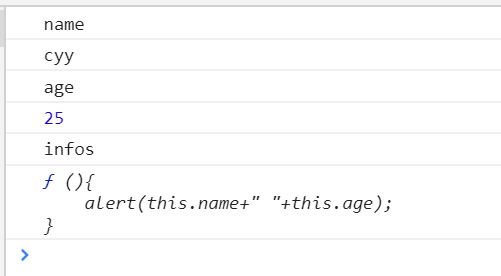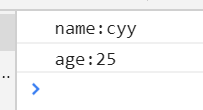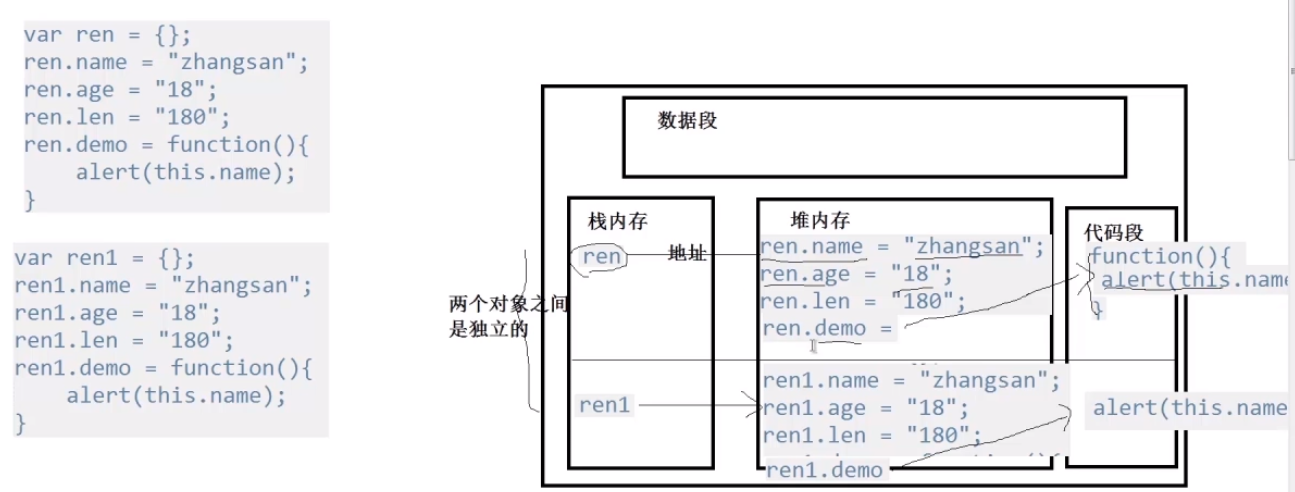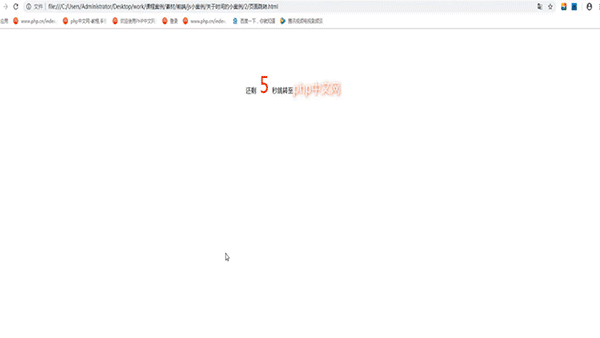对象的遍历
对象可以当做数组处理,使用for in
var person={}; person.name="cyy"; person.age=25; person.infos=function(){ alert(this.name+" "+this.age); } for(var i in person){ console.log(i);//属性名或方法名 console.log(person[i]);属性值或方法值 }

使用构造函数声明的对象,需要实例化之后再进行遍历
Person(){ this.name="cyy"; this.age=25; } var p=new Person(); p){ console.log(i+":"+p[i]); }

对象在内存中的分布
参考以下神图

封装:把对象的内部数据和操作细节进行隐藏
提供private关键词隐藏某些属性和方法,限制被封装的数据或者内容的访问,只对外提供一个对象的专门访问的接口
接口一般为调用方法
不过js没有提供这样的关键词,但可以通过闭包来实现
函数内部声明的变量,外部是访问不到的
fn(){ var n=1 fn2(){//特权方法 alert(++n); } return fn2; } fn()();2
封装 var name="cyy" _name(){ alert(name); } this.name=function(){这是给外部的接口 _name; } } var fn=p.name(); fn();cyy
封装的缺点:1、占用内存 2、不利于继承
利用闭包特性来封装一个对象student,运用对象student存储一个学生的信息,信息包括姓名,性别和年龄,这些信息不可被外部直接访问,只能通过对象的方法获取
student的数据结构如下:

Student(){ var obj={}; _set(name,sex,age){ obj.name=name; obj.sex=sex; obj.age=age; } _get(){ return obj.name+" "+obj.sex+" "+obj.age; } obj.get=对外接口 _get; } obj.set= _set; } obj; } var stu= Student; stu.set()("小明","男",23); console.log(stu.get()());小明 男 23
原型和原型链
原型:利用 prototype 添加属性和方法,prototype对象
原型链:JS在创建对象时,有一个 __proto__ 的内置属性,指向它的原型对象 prototype
var Person=(){} Person(); Person.prototype.say=(){ alert("老娘超美"); } p.say(); /* p没有say方法,所以会去p.__proto__里找 p.__proto__是一个对象,指向Person.prototype Person.prototype中有say方法 */ 创建对象的过程 1、创建对象 var p={} 2、将Person的原型对象赋值给p p.__proto__=Person.prototype 3、初始化对象p Person.call(p) */ alert(p.__proto__==Person.prototype);true
原型和原型链,实现原型继承
function(){}Person是一个对象 Person.prototype.say=(){ alert("陈莺莺超美"); } var Cyy=function(){};Cyy也是一个对象 Cyy.prototype=new Person();将Cyy的原型指向Person,实现Cyy继承自Person Cyy.prototype.sing=(){ alert("陈莺莺会唱歌"); } var me= Cyy(); me.say();陈莺莺超美 me.sing(); 陈莺莺会唱歌 分析:me.__proto__ -> Cyy.ptototype -> Person.prototype Person是父 Cyy是子 继承:如果子类中没有的,会继承自父类;如果子类和父类中都有,那么子类的会覆盖掉父类的 */
__proto__ 实现原型继承
Person(name,age){ name; this.age=age; } Person.prototype.say= Student(){}; Student.prototype=new Person("cyy",25); Person是Student的父类 //子类必须继承自父类的实例 Student.prototype.grade=3; Student.prototype.test=.grade); } var s= Student(); s.say();cyy 25 s.test();3s.__proto__ -> Student.prototype -> Person.prototype
原型的值可以是一个对象,也可以是null
原型链的最终指向null
alert(Object.prototype.__proto__);null
情况一 Parent(){ this.name="parent"this.age=45 Child(){ ; } Child.prototype.name="child"; Child.prototype= Parent(); var c= Child(); console.log(c.name);parent 情况二 ; } Child.prototype= Parent(); Child.prototype.name="child"; child
情况一中,Child.prototype=new Parent(); 这一句覆盖掉了前面的 Child.prototype.name="child";
属性的值与代码执行顺序有关,后继承的父级的,会覆盖住先定义的自己的
创建一个动物类的对象,对象中有动物名称和数量的属性 。创建一个猫的对象并继承动物类对象 ,并为猫对象定义一个方法 。实例化一个猫对象 ,调用其方法 ,弹出动物名称和数量
Animal(name,number){ this.number=number; } Cat(){}; Cat.prototype=new Animal("cat",30); Cat.prototype.info=.number); } Cat(); c.info();cat 30
构造函数的继承
在子类内部构造父类的对象来实现继承
父对象被子对象继承后,所有的属性和方法,都会传递到子对象中
Parent(name){ this.pSay=(){ alert(.name); } } Child(name,1)">this.obj=Parent; this.obj(name);继承了父元素中的两句代码 age; this.cSay=.age); } } new Parent("爸爸"); p.pSay();爸爸 new Child("女儿",1)">); c.cSay();女儿 25 c.pSay();女儿
对象内置方法中的apply和call都可用于继承,两者的区别在于传参方式不同
obj.call( 方法,var1,var2...)
obj.apply( 方法,[var1,var2...])
Parent(name,age,sex){ this.sex=sex; this.say=this.age+" "+.sex); } } 实现继承 Parent.call(this,name,age);this是指Child } Child2(name,1)">实现继承 Parent.apply(} new Child("cyy",1)">); c.say(); cyy 25 undefinedChild也拥有了Parent的属性和方法 var c2=new Child2("cyy2",1)">); c2.say();cyy2 25 undefined
使用构造方法创建一个动物类对象Animal, 对象中定义属性有动物名称和数量,并且定义一个方法。再创建两个动物的对象(如猫和狗),一个动物使用call方法实现继承Animal, 一个动物使用apply方法实现继承Animal。分别实例化两个动物并弹出动物的名称和数量
this.num=num; this.getInfo=.num); } } Cat(name,num){ Animal.call(,num); } Dog(name,num){ Animal.apply(new Cat("cat",20); c.getInfo();cat 20 var d=new Dog("dog",1)">); d.getInfo();dog 30
JS面向对象的关键词
instanceof 变量是否是对象的实例
var arr= Array(); console.log(arr instanceof Array);true console.log(arr instanceof Object);true Person(){}; Person(); console.log(p instanceof Person);true console.log(p true
delete 删除对象属性(不能删除原型链中的属性和方法)
this.eat=(){ alert("吃饭"); } } Person(); console.log(p.name);cyy delete p.name;删除对象的属性 console.log(p.name);undefined p.eat();吃饭 delete p.eat();吃饭 删除对象的方法,失败 p.eat();吃饭 ; console.log(name);delete name; console.log(name);name is not defined
call 参数逐个实现继承
apply 参数以数组方式实现继承
add(a,b){ alert(a+b); } sub(a,b){ alert(a-b); } add.call(sub,4,812 调用的是add这个方法 add.call(sub2,4,1)">sub2 is not defined 只能引用一个已经存在的对象 add.apply(sub,[3,2]);
Animal(){ this.name="animal"this.show= Cat(){ this.name="cat"var a= Animal(); Cat(); a.show.call(c);cat c拥有了a所拥有的show方法 a.show.apply(c,[]);cat c拥有了a所拥有的show方法
创建两个数组 ,并运用apply实现两个数组的拼接
var arr1=[2,3]; var arr2=[4,5]; arr1.push.apply(arr1,arr2); 调用的是apply前面的方法:arr1.push console.log(arr1);
arguments 实参的类数组对象
callee 返回正在执行的function对象,返回的是function的内容
arguments.callee
fn(){ console.log(arguments.callee); ƒ fn(){ console.log(arguments.callee); } */ console.log(arguments.callee());不停调用自身,陷入死循环 } fn();
常用于递归函数调用函数自身
var sum=(n){ if(n<=1) return 1return n+sum(n-1); } console.log(sum(4));10
return n+arguments.callee(n-110
this 指向当前对象
1、this函数调用
var x=1this.x=2;this改变的是全局变量的x的值 } fn(); console.log(x);2
2、this作为方法调用
构造函数内指代当前对象
Person(); p.show();cyy
3、在call和apply中,this作为第一个参数
show(){ alert(.name); } {}; obj.name="cyy2"; obj.showName=show; obj.showName.apply();调用show(),this指向全局 obj.showName.apply(window);同上 obj.showName.apply(obj);调用show(),this指向obj
用arguments计算参数总和
sum(){ var sum=0var i=0;i<arguments.length;i++){ sum+=arguments[i]; } sum; } console.log(sum(2,5,7));14
对象冒充:将父类的属性和方法传给子类,作为特权属性和特权方法
this.name=name;特权属性 特权方法 alert(.age); } } Parent.prototype.walk=非特权方法 alert("walking..."this.obj=Parent;对象冒充,可以使用父类的特权属性和特权方法 .obj(name,age); sex; } ); c.show();cyy 25 c.walk(); c.walk is not a function

 js如何实现弹出form提交表单?(图文+视频)
js如何实现弹出form提交表单?(图文+视频) js怎么获取复选框选中的值
js怎么获取复选框选中的值 js如何实现倒计时跳转页面
js如何实现倒计时跳转页面 如何用js控制图片放大缩小
如何用js控制图片放大缩小